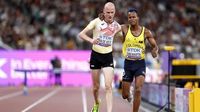On a night when world champions were crowned and medals gleamed under the Tokyo stadium lights, it was a moment of raw sportsmanship between two steeplechasers that truly stole the spotlight at the World Athletics Championships. Belgian runner Tim Van de Velde, just 25 years old, found himself in the thick of the men’s 3,000-meter steeplechase heat—not as a medal contender, but as a beacon of camaraderie on September 13, 2025.
The drama unfolded as the field navigated the grueling 7.5-lap race, which demands not only speed and endurance but also technical prowess to vault five 3-foot-high barriers each lap, including the infamous 2-foot-deep water jump. Van de Velde, a former European Youth Champion, was running in front as the athletes approached the water pit to start the third lap. In a split second, disaster struck. He clipped the barrier, tumbled into the water, and with that, his hopes for a top finish evaporated.
“I know what it’s like to feel helpless on the track,” Van de Velde later reflected, drawing on a well of personal experience. This wasn’t his first brush with misfortune. Just last year, at the European Championships, he broke his collarbone in a fall. And at the 2022 World Championships in Eugene, Oregon, he suffered an ankle injury after another spill into the water pit. For an athlete whose career has been punctuated by both triumph and tribulation, empathy comes naturally.
But the night’s defining moment came not from Van de Velde’s own misadventure, but from what he did next. Glancing behind him in the final stretch, he spotted Colombian rival Carlos San Martin, struggling mightily after a punishing journey. San Martin, who had been vying for a qualifying spot himself, was now gingerly crawling over the last barrier, his body spent and his spirit clearly tested.
Van de Velde’s competitive ambitions might have been dashed, but his sense of sportsmanship was undimmed. Without hesitation, he turned around, reached out, and put an arm around the stumbling San Martin. Together, they limped toward the finish, sharing a moment that would be remembered long after the medals had been awarded. “I saw him stumbling and thought, ‘Why not?’” Van de Velde explained. “We both had bad luck, I guess. Maybe we can share some bad luck together.”
The crowd responded with a swell of applause, recognizing a gesture that transcended the race itself. In a sport where every second can mean the difference between glory and heartbreak, Van de Velde’s decision to help a rival—rather than simply chase his own finish—spoke volumes about the spirit of competition. “We’re both competitors. We both work very hard,” Van de Velde added. “Of course, the main goal was the final and we both had bad luck, so that’s why I did it.”
The steeplechase, with its relentless barriers and unforgiving water jumps, is notorious for testing both body and mind. For Van de Velde and San Martin, the 3,000 meters became a lesson in resilience and mutual respect. As Van de Velde steadied his rival, the two crossed the line in 10th and 11th place—far from the podium, but firmly in the hearts of those watching.
San Martin’s ordeal didn’t end at the finish line. He was helped off the track in a wheelchair, clearly spent from the effort. He did not pass through the post-race interview area, leaving Van de Velde to speak for them both. The Belgian’s words resonated with everyone who’s ever faced adversity on the track: “It will take time to get over this latest disappointment. The good news is there’s a great chance he will be remembered for something other than where he finished.”
While the steeplechase heat was just one chapter of a busy opening night at the championships, it was arguably the most talked-about. Five gold medals were handed out across various events, each representing years of training and sacrifice. Yet, as the stadium buzzed with excitement over the crowning of new champions, it was the image of Van de Velde and San Martin, side by side, that lingered in the air.
Track and field has always been about more than just times and distances. It’s about the stories that unfold between the start and finish lines—the moments of heartbreak, redemption, and, occasionally, selflessness. Van de Velde’s act of kindness wasn’t born out of obligation or a desire for attention. It was a spontaneous gesture, rooted in a deep understanding of what it means to be vulnerable, to fall, and to need a helping hand.
For Van de Velde, the pain of another missed opportunity was softened, if only slightly, by the knowledge that he’d made a difference. “Maybe we can share some bad luck together,” he mused, a sentiment that captured both the disappointment and the camaraderie of the night. For San Martin, the support may have been the only thing that got him across the line—a reminder that in the world of elite athletics, even rivals can be allies when the chips are down.
The Tokyo World Athletics Championships will be remembered for its champions and record-breakers, but also for this singular act of sportsmanship. As the athletes prepare for the next round and the spotlight shifts to new contenders, Van de Velde’s gesture serves as a powerful reminder of what makes sport truly great. It’s not just about crossing the finish line first—it’s about how you run the race, and who you help along the way.
With a packed schedule and more medals on the horizon, the championships continue to deliver drama, excitement, and the occasional surprise. But for now, the story of Tim Van de Velde and Carlos San Martin stands as a testament to the enduring power of empathy and respect in the heat of competition. As the world watched, two athletes found common ground—not in victory, but in the simple, profound act of finishing together.
